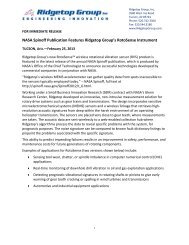Ball Grid Array (BGA) Solder Joint Intermittency Detection: SJ BIST
Ball Grid Array (BGA) Solder Joint Intermittency Detection: SJ BIST
Ball Grid Array (BGA) Solder Joint Intermittency Detection: SJ BIST
- No tags were found...
Create successful ePaper yourself
Turn your PDF publications into a flip-book with our unique Google optimized e-Paper software.
4. PIN SELECTIONOur recommendation is the following: A deployed <strong>SJ</strong> <strong>BIST</strong>application should use at least four groups of cores: onegroup of two I/O pins near each corner of the FPGA dieshadow or at each corner of the FPGA package (the pinkshadedpins in Figure 15). Research indicates the solderballs nearest the corner of the package or the FPGA die aremost likely to fail first. The stress diagram in Figure 16indicates that of the two areas, the corners nearest the FPGAdie are likely to fail first. High stress caused by physicalmounting coupled with thermal-mechanical stresses is themost likely cause of the observed failure distribution ofsolder balls in <strong>BGA</strong> packages. Further evidence of thevalidity of these observations is the reserving of the four I/Opins at each corner for ground and all of the pins under thedie for power and ground (the orange-shaded pins).5. TEST ACTIVITIESExtensive experiments, including HALTs, have beenplanned and are presently being conducted. The primaryobjectives are the following: (1) perform final sensitivity,resolution and clock frequency measurements to verifyFigure 14; (2) collect, evaluate and publish statistical datarelated to test I/O port location, first failure and probabilityof failure distribution. The pink- and light-blue-shaded pinsin Figure 15 are the sixty-four pins we selected for HALTtesting: 32 groups of two-pin <strong>SJ</strong> <strong>BIST</strong> cores.HALT Test BoardFigure 16: FG1156 Strain Diagram.Figure 17 is a block diagram of the HALT test board wedesigned. The <strong>SJ</strong> <strong>BIST</strong> test program is loaded into aPROM, which then loads the program into each FPGA whenthe board is powered on. Each FPGA generates 640 bits ofdata (64 x (2 faults signals + 8 bits of count)); each boardgenerates 2560 bits of data. We wrote a LabVIEW®program to control the collection of data, and we wrote aMATLAB® program to process the data.Figure 18 shows a manufactured, populated and solderedHALT test board. There are three connectors: (1) XILINXprogrammer connection, (2) power input and (3) experimentcontrol connections.Figure 15: FG1156 I/O Pin Footprint [22].Figure 17: HALT Test Board Block Diagram.6





